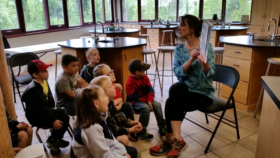 Yet another Earth Day celebration is scheduled at Crossroads this week. Five Kindergarten classes from Sunset School will celebrate Earth Day with a wildlife lesson from DNR Warden Chris Kratcha, by singing songs about nature, by participating in a service project of spreading wood chips on one of our new trails, and by planting butterfly-friendly wildflowers for our new Bird and Butterfly Garden.
Yet another Earth Day celebration is scheduled at Crossroads this week. Five Kindergarten classes from Sunset School will celebrate Earth Day with a wildlife lesson from DNR Warden Chris Kratcha, by singing songs about nature, by participating in a service project of spreading wood chips on one of our new trails, and by planting butterfly-friendly wildflowers for our new Bird and Butterfly Garden.The kindergarten children will learn that caterpillars eat the leaves of specific host plants, but adult butterflies feed on the nectar of a variety of flowers. So our new gardens needs to contain host plants and also species selected so the garden will have blooming flowers throughout the growing season.
So the children, using special molds, will create soil blocks and then plant a variety of native wildflowers which we will tend in our Greenhouse until the seedlings are ready to transplant into the areas near the bathroom and lecture hall exits of the Collins Learning Center. When the kids return to Crossroads as 2nd or 3rd graders, they will see the butterflies feeding from “their flowers.” And observe songbirds feeding their nestlings with caterpillars.
The Greenhouse will be a busy place on Sunset Earth Day because that evening is the final session of our Family Garden Class. Eleven families have spent the past month learning about gardens—and they also have learned that flowers attract insects. In vegetable gardens we want to attract pollinating bees–both wild and domestic.
At the end of the class, each family will take home a box of vegetable plants so they can grow their own food this summer. But before they leave, they will learn by doing, helping volunteers from Master Gardeners plant the Heritage Garden at Crossroads. Families will transplant some of their seedlingsand also plant potatoes. Bees aren’t that important for growing carrots and potatoes because they are root crops. We eat the leaves of lettuce, spinach and cabbage so they don’t need bees. But bees are necessary for growing fruit, berries, and cucumbers and squash. Peppers, beans and tomatoes can pollinate themselves, but these plants have much better yields if bees visit them.
Because bees cannot hover, they prefer gently cupped flowers or flat blossoms with a single ring of petals around a central disk, not just because they can land on them, but also, because simple flowers actually produce more nectar and pollen. Double flowers and many of the newer cultivars—which admittedly are very pretty—generally have more petals but fewer pollen-baring anthers. Finding the nectar glands among all those confusing petals is time-consuming and difficult for bees.
Oddly, bees cannot see the same colors we do. Apparently, bee don’t respond to the color red. To attract bees, purple, blue, and yellow flowers ( planted in clumps) work best.
Not surprisingly, most spring wildflowers are purple, blue, yellow, or white (which actually are ultraviolet, a color we humans cannot see). This week’s wildflower hikes will be revealing. Last fall, we developed multi-use winter trails through the Big Creek Preserve. Because these trails travel through “new territory” we have no ideas what wildflowers we may (or may not) find. Two one-hour walks of discovery may help us add species to our plant inventory. The walking will be gentle and the hikes are free and open to the public.
Crossroads at Big Creek is a donor supported facility made up of the Big Creek, The Cove, and the Ida Bay preserves. The Collins Learning Center, located at 2041 Michigan just east of the Highway 42/57 Roundabout in Sturgeon Bay, is open 2:00-4:00 daily and during scheduled activities. Trails in all preserves are open 24/7 free of charge.
Saturday, May 20 1:00 Wildflower Walk along Big Creek
Last fall, we developed multi-use winter trails parallel Big Creek. Because these trails travel through “new territory” we have no ideas what wildflowers we may (or may not) find. This one-hour walk of discovery may help us add species to our plant inventory. The one hour walk will be gentle and free and open to the public. Meet at the Collins Learning Center.
Sunday, May 21 1:00 Hike the Lilac Ridge A massive invasive species eradication effort last summer opened two new trails overlooking the Big Creek Valley. This hike will offer a new vista the preserve and let us observe the first stages of habitat recovery. About an hour. Meet at the Collins Learning Center.

